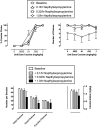Effects of monoamine releasers with varying selectivity for releasing dopamine/norepinephrine versus serotonin on choice between cocaine and food in rhesus monkeys
- PMID: 22015808
- PMCID: PMC3476464
- DOI: 10.1097/FBP.0b013e32834d63ac
Effects of monoamine releasers with varying selectivity for releasing dopamine/norepinephrine versus serotonin on choice between cocaine and food in rhesus monkeys
Abstract
Monoamine releasers constitute one class of candidate medications for the treatment of cocaine abuse, and concurrent cocaine-versus-food choice procedures are potentially valuable as experimental tools to evaluate the efficacy and safety of candidate medications. This study assessed the choice between cocaine and food by rhesus monkeys during treatment with five monoamine releasers that varied in selectivity to promote the release of dopamine and norepinephrine versus serotonin (5HT) [m-fluoroamphetamine, (+)-phenmetrazine, (+)-methamphetamine, napthylisopropylamine and (±)-fenfluramine]. Rhesus monkeys (n=8) responded under a concurrent-choice schedule of food delivery (1-g pellets, fixed ratio 100 schedule) and cocaine injections (0-0.1 mg/kg/injection, fixed ratio 10 schedule). Cocaine choice dose-effect curves were determined daily during continuous 7-day treatment with saline or with each test compound dose. During saline treatment, cocaine maintained a dose-dependent increase in cocaine choice, and the highest cocaine doses (0.032-0.1 mg/kg/injection) maintained almost exclusive cocaine choice. Efficacy of monoamine releasers to decrease cocaine choice corresponded to their pharmacological selectivity to release dopamine and norepinephrine versus 5HT. None of the releasers reduced cocaine choice or promoted reallocation of responding to food choice to the same extent as when saline was substituted for cocaine. These results extend the range of conditions across which dopamine and norepinephrine-selective releasers have been shown to reduce cocaine self-administration.
Figures








References
-
- Arnold JM, Roberts DCS. A Critique of Fixed and Progressive Ratio Schedules Used to Examine the Neural Substrates of Drug Reinforcement. Pharmacol Biochem Behav. 1997;57:441–447. - PubMed
-
- Bergman J. Medications for stimulant abuse: agonist-based strategies and preclinical evaluation of the mixed-action D-sub-2 partial agonist aripiprazole (Abilify) Exp Clin Psychopharmacol. 2008;16:475–483. - PubMed
Publication types
MeSH terms
Substances
Grants and funding
LinkOut - more resources
Full Text Sources

